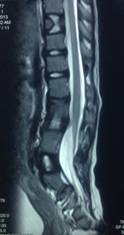C A S E O F T H E M O N T H
TETHERED SPINAL CORD
(BY A THICKENED FILUM TERMINALE)

A 5-year-old girl was noted to have repeated episodes of urinary tract infection. On further testing, it was found that she had a “tethered cord” and that she was not able to empty her urinary bladder completely, leading to residual urine in her bladder and repeated episodes of urinary infection. Upon the advice of the urologist, the patient’s mother had to empty the little girl’s bladder every 4 hours with a straight rubber catheter to prevent further infections. The child was also referred to a neurosurgeon.
On examination, the little girl was active and playful. The skin over her lower back appeared normal except for a small dimple in the middle. She had normal strength in her legs and she denied having any numbness.
MRI of the lumbosacral spine (lower back) showed some bony abnormalities in the spine, as well as a “tethered” spinal cord. In this case, the tip of the spinal cord ended at a level several centimeters lower than it should have, and seemed to be tethered at the base. The tethered spinal cord may lead to problems with urinary and bowel function, as well as weakness and numbness of the legs when the patient grows older and taller.
The patient underwent laminectomy (removal of the bone at the back of the spine) and detethering of the spinal cord. During the operation, the lower end of the spinal cord, called the filum terminale, was noted to be thick and fat, instead of its normal slender appearance. This condition is called a thickened filum terminale. The filum was cut so that the spinal cord will be released from its tether and will not be anchored to the base any more.
The surgery went well and the patient did not develop any weakness or numbness in her legs. After 2 weeks, her mother was happy to report that the patient was able to urinate on her own without needing a catheter. Further tests would have to be done to check her bladder function. She was advised to have close regular follow-up visits with her doctors to monitor her condition. |